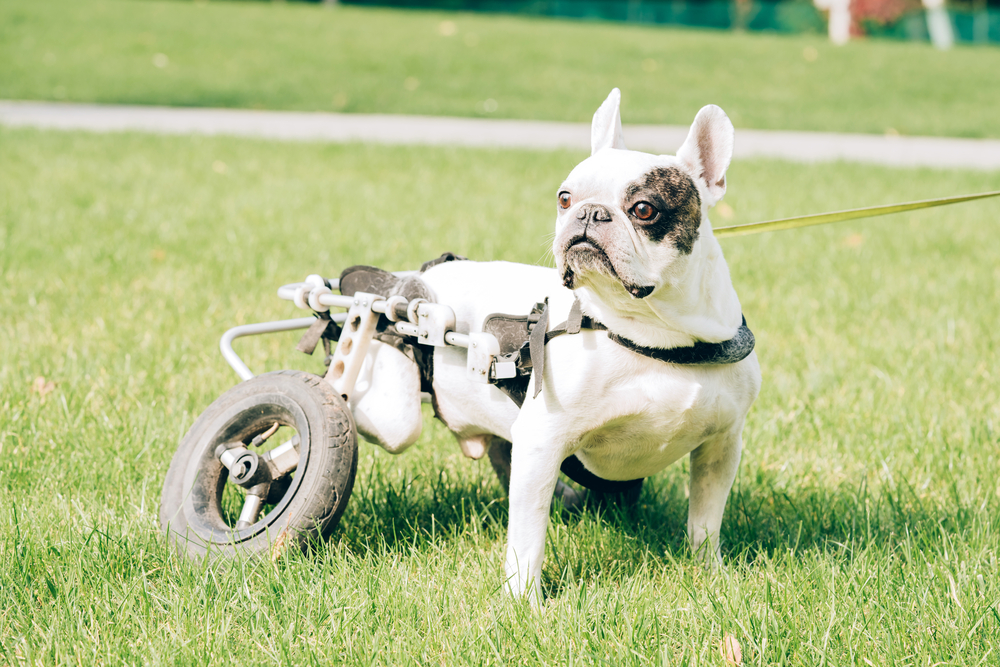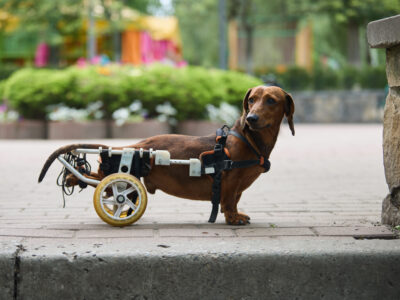The first warning sign that told me, my dog had a mobility problem, happened in the hallway of my house. Sophie, my 10-year-old shepherd mix, was walking next to me as we headed from the living room to the kitchen. We made a right turn down the hallway and her hind legs slipped out from under her. She fell hard onto the tile floor.
Note: Some of the links in this article are Amazon affiliate links where I earn from qualifying purchases. Read our policy.
My initial thought was that something had spilled on the floor. I checked for wet spots, but the tile was completely dry. I remember thinking the incident was strange, but Sophie picked herself off the ground and was prancing around like she usually did, so I put any worries out of my head.
A week later, Sophie had a second event that caught my attention. She stopped during our daily walk to lie down on a neighbor’s lawn. Normally Sophie was the fastest walker of my three dogs, but that day she seemed to have trouble keeping up with her housemates.
Over the next few months, my dog’s mobility got worse and her symptoms became more frequent. The slips and falls happened daily, and she had trouble getting up from the slick tile floor. Our veterinarian explained that Sophie showed the early signs of a neurological disease called Degenerative Myelopathy.

General symptoms of dog mobility problems
It can be tricky to decipher the warning signs of mobility problems. Some of them are bold, like your dog taking a fall and other symptoms, like mild stiffness when your dog stands up, are hard to notice.
It pays to be vigilant. The earlier you catch a change in your pup’s behavior, the sooner treatment can start.
According to the American Animal Hospital Association, mobility problems in dogs are on the rise. This is in part because our dogs are living longer and, once they’re diagnosed with a health problem, more pet parents are willing to provide treatment.
AAHA estimates that 1 in 5 dogs will experience a mobility issue during their lifetime.
If you suspect that your dog is developing a problem, talk with your veterinarian right away. Ask about getting a full workup so a diagnosis can be made, and a treatment plan can be implemented.
Here are common warning signs of mobility problems in your dog
- Limping or Favoring a Leg: If your dog is consistently favoring one leg, limping or refusing to put weight on the limb, it could indicate pain or discomfort.
- Difficulty Getting Up: If your dog has trouble getting up from a lying position, especially on a slick floor, there could be joint or muscle problems. This is a common first sign of osteoarthritis.
- Struggling to Stand or Sit: Dogs who find it hard to stand up or sit down, might have joint of muscle issues.
- Slips and Falls: These two symptoms can be warning signs of arthritis, muscle weakness or a neurological health problem.
- Stiffness or Slowness: If your dog is stiff, moves slower than usual, or has difficulty walking with smooth steps, especially after rest, it might be a warning sign of arthritis or other joint-related problems.
- Shaking or Trembling: Dogs don’t typically shake from the cold, but their bodies do shake when they’re in extreme pain.
- Reluctance to Jump or Play: If your dog hesitates or refuses to jump onto the sofa, hop into the car, or play their favorite game, it may signal muscle pain, a ruptured disc or the first stages of a neurological disease such as Intervertebral Disc Disease (IVDD).
- Trouble Climbing Stairs: Difficulty navigating the stairs can suggest joint pain, joint weakness arthritis or a neurological disease.
- Decreased Activity: A sudden decrease in activity or a reluctance to participate in physical activities your dog loves, can be a mobility warning sign.
More of the warning signs for your dog

- Changes in Gait: Changes in how your dog walks can point to a problem. The symptoms can be a limp or taking uneven steps. Both can be symptoms of pain or a musculoskeletal problem, like arthritis.
- Licking or Chewing at Joints: Excessive licking or chewing at specific joints can be a sign of discomfort in that area.
- Changes in Posture: An unusual posture, like a hunched or arched back or a reluctance to lower the head, may suggest a spine or neck injury.
- Whining or Vocalizing: Persistent whining, whimpering, or vocalizing, especially when being touched or during movement, indicates pain and discomfort.
- Weight Shifts: If your dog tends to shift weight to one side or avoids putting weight on a particular limb, it could be a sign of pain.
- Knuckling the Paws: This symptom points to a neurological condition such as IVDD or Degenerative Myelopathy (DM). Dogs curl or “knuckle under” their paws, when they can’t feel their foot or don’t realize where it is in relation to the rest of their body.
- Dragging a Paw: Dogs drag a paw when they’ve lost feeling in it or when it’s too painful to walk on it.
- Muscle Atrophy: Loss of muscle mass, particularly if it’s in one leg, can be a warning sign of an injury or a neurological health problem.
If you notice any of these warning signs, it’s crucial to seek veterinary attention. Early intervention and care can improve your dog’s quality of life and help manage underlying mobility issues.
My favorite products for dogs with mobility problems

Products that improve traction:

Get the Essential Guide
The Essential Guide of Products for Handicapped Dogs e-book is a labor of love for me. I wrote it to answer your most pressing questions about where to find the best products for your wheelchair dog. You’ll find products you didn’t know existed and each will improve your dog’s quality of life. Print a copy and keep it by your side.





Leave a Reply